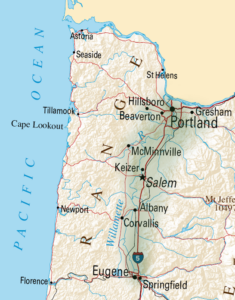Canola Quick Bytes
A supplement to U.S. Canola Digest
Capitol Hill
On Feb. 22, the U.S. Food and Drug Administration (FDA) released guidance on voluntary premarket engagement for companies wishing to bring to market foods derived from gene-edited plants. For crops that pose no food safety questions, a voluntary premarket meeting with the FDA is enough. For other crops, a premarket consultation process is recommended in line with what is standard practice for new biotech traits. “Participation in these programs is not required by law, but [they] can help developers ensure that they are meeting their legal obligation to market only safe and lawful food,” the FDA says in the guidance. While modern molecular biology methods can provide detailed information about the genetic changes in a new plant variety, the objective characteristics of the food ultimately are most relevant to food safety, rather than the breeding method or type of genetic modification by which the plant was produced.
 The U.S. Canola Association (USCA) submitted comments to the California Air Resources Board (CARB) on Feb. 20 on its proposed low-carbon fuel standard (LCFS) amendments issued on Dec. 19, 2023. The USCA urges CARB to recognize that fuels produced and certified under the federal Renewable Fuel Standard meet CARB’s proposed sustainability criteria. Additional requirements would place an unnecessary burden on fuel and feedstock providers as well as on CARB’s staff and resources for LCFS implementation and enforcement. In addition, the LCFS already accounts for land use change emissions in its lifecycle methodologies so more certification requirements would be redundant and create unnecessary burdens and expenses. The U.S. Canola Association (USCA) submitted comments to the California Air Resources Board (CARB) on Feb. 20 on its proposed low-carbon fuel standard (LCFS) amendments issued on Dec. 19, 2023. The USCA urges CARB to recognize that fuels produced and certified under the federal Renewable Fuel Standard meet CARB’s proposed sustainability criteria. Additional requirements would place an unnecessary burden on fuel and feedstock providers as well as on CARB’s staff and resources for LCFS implementation and enforcement. In addition, the LCFS already accounts for land use change emissions in its lifecycle methodologies so more certification requirements would be redundant and create unnecessary burdens and expenses.
On Feb. 7, the Environmental Protection Agency (EPA) released an update on its Endangered Species Workplan, reflecting stakeholder feedback since the 2022 draft and three comment periods. The EPA will develop species maps and an online mitigation menu, recognize practice definitions of the U.S. Department of Agriculture’s Natural Resource Conservation Service, host a mitigation workshop in April and create a draft insecticide strategy by summer 2024. USCA President Andrew Moore represented the association on Feb. 26 at an EPA Interagency Working Group with other agricultural groups to provide input on EPA’s efforts to comply with the Endangered Species Act for pesticide decisions.
 Moore also participated in a commodity group grower leader forum on Feb. 14 in Washington, D.C. It was hosted by the National Corn Growers Association and attended by representatives from commodity groups for corn, soy, wheat, sorghum, barley, pulses, sugar, peanuts, pork and dairy as well as the Farm Bureau and National Farmers Union. Producers discussed their biggest opportunities and challenges, including trade deficits, lack of new trade agreements, China dynamics and labor. [insert photo] Moore also participated in a commodity group grower leader forum on Feb. 14 in Washington, D.C. It was hosted by the National Corn Growers Association and attended by representatives from commodity groups for corn, soy, wheat, sorghum, barley, pulses, sugar, peanuts, pork and dairy as well as the Farm Bureau and National Farmers Union. Producers discussed their biggest opportunities and challenges, including trade deficits, lack of new trade agreements, China dynamics and labor. [insert photo]
Renewable fuel stakeholders and associated tax experts said that the federal government should be wary of the “devastating” impact that an upcoming decision on GREET emissions modeling could have on the ability for the industry to begin producing significant amounts of sustainable aviation fuel (SAF), reported OPIS. In turn, this could thwart progress on President Joe Biden’s SAF Grand Challenge from 2021, which pledged for the United States to reach 3 billion gallons per year of domestically produced SAF by 2030 and 50 billion by 2050.
Agronomy
 The Oregon House voted on Feb. 22 to keep a 500-acre cap on canola production in the Willamette Valley through early 2028 to buy time to evaluate the potential impact of biotech canola in the region, reported OPB News. Since 2013, the legislature has put in place this limit on canola in the protected district, stretching from Multnomah to Lane County, because other Brassica crops are grown in the region and can cross-pollinate without isolation distances. Yet canola is a good rotational crop with grass seed because it improves soil health and combats weeds, plus it can supplement a farmer’s income. A compromise version. HB4059, would have expanded non-biotech canola production to 2,500 acres initially and then lifted all limits after the 2025 harvest. It also would have permanently limited biotech canola to 500 acres, set an isolation distance with other Brassica crops and directed the Oregon Department of Agriculture to set up a public tracking map to avoid conflicts. The Oregon House voted on Feb. 22 to keep a 500-acre cap on canola production in the Willamette Valley through early 2028 to buy time to evaluate the potential impact of biotech canola in the region, reported OPB News. Since 2013, the legislature has put in place this limit on canola in the protected district, stretching from Multnomah to Lane County, because other Brassica crops are grown in the region and can cross-pollinate without isolation distances. Yet canola is a good rotational crop with grass seed because it improves soil health and combats weeds, plus it can supplement a farmer’s income. A compromise version. HB4059, would have expanded non-biotech canola production to 2,500 acres initially and then lifted all limits after the 2025 harvest. It also would have permanently limited biotech canola to 500 acres, set an isolation distance with other Brassica crops and directed the Oregon Department of Agriculture to set up a public tracking map to avoid conflicts.
Canola growers: March 15 is the final date to apply for 2024 crop insurance for spring crops via the U.S. Department of Agriculture’s Risk Management Agency. Current policyholders who wish to make changes must also do so by this date. Farmers can use the RMA Cost Estimator to predict their insurance premium.
Nutrition
 The Wall Street Journal reported on Jan. 22 about seed oils to debunk myths about them on social media. “All the evidence, strong evidence, is that seed oils, which are rich in healthy, unsaturated fats, are really good for our health,” said Dr. Dariush Mozaffarian, cardiologist and professor of nutrition and medicine at Tufts University. “These extracts from seeds are among the most nutrition-packed foods on the planet.” Studies have found that people with higher blood levels of linoleic acid, the main omega-6 fat found in seed oils, have a lower risk of cardiovascular disease, stroke and type 2 diabetes than people with lower blood levels of this type of fat. In general, nutrition experts recommend reducing saturated fats in the diet, replacing them with unsaturated fats, which are found in seed oils. The Wall Street Journal reported on Jan. 22 about seed oils to debunk myths about them on social media. “All the evidence, strong evidence, is that seed oils, which are rich in healthy, unsaturated fats, are really good for our health,” said Dr. Dariush Mozaffarian, cardiologist and professor of nutrition and medicine at Tufts University. “These extracts from seeds are among the most nutrition-packed foods on the planet.” Studies have found that people with higher blood levels of linoleic acid, the main omega-6 fat found in seed oils, have a lower risk of cardiovascular disease, stroke and type 2 diabetes than people with lower blood levels of this type of fat. In general, nutrition experts recommend reducing saturated fats in the diet, replacing them with unsaturated fats, which are found in seed oils.
 March is National Nutrition Month®, an annual observance by the Academy of Nutrition and Dietetics that calls attention to developing sound eating and exercise habits. This year’s theme is “Beyond the Table,” which addresses the farm-to-fork aspect of nutrition from food production to home food safety. “Stay nourished on any budget” is one of its messages. Canola oil is a great fit as it is heart-healthy, versatile and affordable: Just 1.5 tablespoons a day in place of saturated fat can reduce the risk of heart disease for pennies a day. March is National Nutrition Month®, an annual observance by the Academy of Nutrition and Dietetics that calls attention to developing sound eating and exercise habits. This year’s theme is “Beyond the Table,” which addresses the farm-to-fork aspect of nutrition from food production to home food safety. “Stay nourished on any budget” is one of its messages. Canola oil is a great fit as it is heart-healthy, versatile and affordable: Just 1.5 tablespoons a day in place of saturated fat can reduce the risk of heart disease for pennies a day.
Other Countries
 On Feb. 26, European farmers protested for the second time last month in Brussels against “hardship they blame on the EU’s green policies, price pressures and import competition,” reported Politico. Tractors blaring their horns at 3 am rolled into the European Quarter where EU farm ministers were later meeting under “heavy guard” by Belgian police, including barbed wire outside EU institutions and the use of water cannons. Protesters set fire to tires, dumped manure on the street and threw hay at police. Farmer unions expressed discontent over falling revenues, excessive environmental burdens, underpayment by food companies and competition from foreign goods These were the same issues that brought farmers to Brussels three weeks before, when angry farmers toppled a statue and hurled eggs at the European Parliament. On Feb. 26, European farmers protested for the second time last month in Brussels against “hardship they blame on the EU’s green policies, price pressures and import competition,” reported Politico. Tractors blaring their horns at 3 am rolled into the European Quarter where EU farm ministers were later meeting under “heavy guard” by Belgian police, including barbed wire outside EU institutions and the use of water cannons. Protesters set fire to tires, dumped manure on the street and threw hay at police. Farmer unions expressed discontent over falling revenues, excessive environmental burdens, underpayment by food companies and competition from foreign goods These were the same issues that brought farmers to Brussels three weeks before, when angry farmers toppled a statue and hurled eggs at the European Parliament.
The European Parliament voted on Feb. 7 to support new genomic techniques, marking a big win for sustainable agriculture in Europe. The plenary vote calls for adoption of modern technologies like gene editing to improve farming practices, food security and environmental protection, reported EuroSeeds.
Canada’s provincial canola grower associations selected 13 new canola research projects for funding under the Canola Agronomic Research Program in 2024. This investment includes $2.1 million+ from Alberta Canola, SaskCanola and the Manitoba Canola Growers Association as well as $1.6 million+ from the Western Grains Research Foundation for a total investment of more than $3.7 million. The projects will focus on understanding the impact of verticillium stripe and its relation to blackleg; clubroot management and monitoring; flea beetle tracking and trapping; and developing novel strategies to improve resiliency against biotic and abiotic threats.
 The biofuels industry could dramatically drive canola demand in the coming decade, noted Chris Vervaet, executive director of the Canadian Oilseed Processors Association at a CropConnect conference in Winnipeg Feb. 14 per Country Guide. “The capacity of crush could grow from 11.3 million metric tonnes today to 18 million metric tonnes in three or four years,” he said. “This is unprecedented.” Roughly 2.5 million tonnes of canola seed are currently used for biofuel markets in Canada, the United States and EU, which Vervaet predicts could grow to 5 million by 2026 and 8 million by 2030. The biofuels industry could dramatically drive canola demand in the coming decade, noted Chris Vervaet, executive director of the Canadian Oilseed Processors Association at a CropConnect conference in Winnipeg Feb. 14 per Country Guide. “The capacity of crush could grow from 11.3 million metric tonnes today to 18 million metric tonnes in three or four years,” he said. “This is unprecedented.” Roughly 2.5 million tonnes of canola seed are currently used for biofuel markets in Canada, the United States and EU, which Vervaet predicts could grow to 5 million by 2026 and 8 million by 2030.
Canola processing companies are gearing up to increase supply for growing demand in the United States for canola oil as a feedstock for lower carbon fuels, reported RealAgriculture. Construction is underway on three of five announced canola crush projects in Saskatchewan – Cargill, Louis Dreyfus and Richardson – which would increase total canola crush capacity in Canada by about 30 percent. Federated Co-op/AGT and Viterra also have plans to build new crush facilities in Sask.
Latest Industry News
In Red River Farm Network’s latest “Canola Minute”, Northern Canola Growers Association Executive Director Barry Coleman discusses a Feb. 15 Canola Renewable Fuels Summit, which indicated demand for canola as a feedstock for renewable fuel will grow in the next decade. “The canola industry will continue to work to ensure that canola is treated fairly in biofuel regulations and captures a significant share of the fuel market in the future,” he said. Andrew Moore and Tom Hance of the USCA and Karen Sowers of the Pacific Northwest Canola Association also attended the summit hosted by BASF at its headquarters in Raleigh, N.C. Topics included market potential for biofuels, factors driving those markets and what it means for canola production.
 A ”Getting-it-Right in Canola Production” virtual meeting will on March 12 from 8:30 am to 12 noon, hosted by North Dakota State University Extension and supported by the Northern Canola Growers Association. There is no fee to attend the Zoom webinar but pre-registration is required. Topics will include agronomic practices in irrigated and dryland canola, such as cultivar selection, seed rate, plant establishment and intercropping, fertilizer recommendations, disease, insect and weed management, and biofuel and crop market updates. A ”Getting-it-Right in Canola Production” virtual meeting will on March 12 from 8:30 am to 12 noon, hosted by North Dakota State University Extension and supported by the Northern Canola Growers Association. There is no fee to attend the Zoom webinar but pre-registration is required. Topics will include agronomic practices in irrigated and dryland canola, such as cultivar selection, seed rate, plant establishment and intercropping, fertilizer recommendations, disease, insect and weed management, and biofuel and crop market updates.
The Pacific Northwest Canola Association (PNWCA) is again pursuing a check-off for canola (and possibly other oilseeds) in Montana. The ballot narrowly missed passing three years ago and funding is needed for Montana-specific canola research.
At the PNWCA annual meeting Jan. 24, three new board members were elected: Joel Wasem (ID), Ben Maney (OR) and Braidy Haden (WA). Wasem succeeds Dale Flikkema as president. With Maney and Haden, the three replace Ray Mosman (ID), Anna Scharf (OR) and Brett Neilsen (WA). Scharf will chair a legislative committee and seeks grower members from Idaho, Oregon and Washington to serve on it.
The PNWCA Canola Workshop in Moscow, Idaho on Jan. 25 sold out for the second year in a row with 215 attendees, more than half of which were growers. Speakers included fellow growers and industry, university and government representatives. Topics included crop and chemical rotation; canola insurance and the farm bill; canola and pulse market dynamics; canola breeding and variety selection; herbicide and weed control strategies; drilling down on stand establishment; fertilizer management; insect pest management; and canola diseases and diagnostics. New this year was a session with “lightning talks” (4-5 min. each) from researchers receiving funding from the Idaho and Washington Oilseed Commissions.
PNWCA Executive Director Karen Sowers presented “Canola in the Northwest U.S.: Why It’s Here to Stay” during the 2024 CropConnect conference in Winnipeg at the invitation of the Manitoba Canola Growers Association. She also gave a 90-minute session about canola for the December 2023 Washington State University Wheat Academy: “A Deeper Dive into Canola Production” with four components featuring hands-on exercises: 1) canola grading and quality; 2) variety selection; 3) macro- and micronutrient interactions and fertilizer strategies; and 4) crop diagnostics. The PNWCA also participated in the Montana Grain Growers Association’s 2023 Trade Show & Convention, which included the Northern Pulse Growers Association.
About the USCA
 The next USCA meeting will be in Washington, D.C., March 18-20, 2024, addressing appropriations, canola oil-based biofuels, the next farm bill, crop protection issues, crop insurance, and stewardship plans for pod shatter tolerance and specialty omega-3 traits. The next USCA meeting will be in Washington, D.C., March 18-20, 2024, addressing appropriations, canola oil-based biofuels, the next farm bill, crop protection issues, crop insurance, and stewardship plans for pod shatter tolerance and specialty omega-3 traits.
Want to see exactly where spring and winter canola is growing in the United States? The USCA has a canola acreage map by county on its website.
Get social with us on Instagram, LinkedIn, Facebook, Twitter and YouTube.
Want to promote your products or services to canola producers and industry members? Visit our advertising pages to find specs, deadlines and rates to advertise in this monthly e-newsletter or on UScanola.com.
|
 The U.S. Canola Association (USCA) submitted comments to the California Air Resources Board (CARB) on Feb. 20 on its proposed low-carbon fuel standard (LCFS) amendments issued on Dec. 19, 2023. The USCA urges CARB to recognize that fuels produced and certified under the federal Renewable Fuel Standard meet CARB’s proposed sustainability criteria. Additional requirements would place an unnecessary burden on fuel and feedstock providers as well as on CARB’s staff and resources for LCFS implementation and enforcement. In addition, the LCFS already accounts for land use change emissions in its lifecycle methodologies so more certification requirements would be redundant and create unnecessary burdens and expenses.
The U.S. Canola Association (USCA) submitted comments to the California Air Resources Board (CARB) on Feb. 20 on its proposed low-carbon fuel standard (LCFS) amendments issued on Dec. 19, 2023. The USCA urges CARB to recognize that fuels produced and certified under the federal Renewable Fuel Standard meet CARB’s proposed sustainability criteria. Additional requirements would place an unnecessary burden on fuel and feedstock providers as well as on CARB’s staff and resources for LCFS implementation and enforcement. In addition, the LCFS already accounts for land use change emissions in its lifecycle methodologies so more certification requirements would be redundant and create unnecessary burdens and expenses. Moore also participated in a commodity group grower leader forum on Feb. 14 in Washington, D.C. It was hosted by the National Corn Growers Association and attended by representatives from commodity groups for corn, soy, wheat, sorghum, barley, pulses, sugar, peanuts, pork and dairy as well as the Farm Bureau and National Farmers Union. Producers discussed their biggest opportunities and challenges, including trade deficits, lack of new trade agreements, China dynamics and labor. [insert photo]
Moore also participated in a commodity group grower leader forum on Feb. 14 in Washington, D.C. It was hosted by the National Corn Growers Association and attended by representatives from commodity groups for corn, soy, wheat, sorghum, barley, pulses, sugar, peanuts, pork and dairy as well as the Farm Bureau and National Farmers Union. Producers discussed their biggest opportunities and challenges, including trade deficits, lack of new trade agreements, China dynamics and labor. [insert photo]
 The Oregon House voted on Feb. 22 to keep a 500-acre cap on canola production in the Willamette Valley through early 2028 to buy time to evaluate the potential impact of biotech canola in the region, reported
The Oregon House voted on Feb. 22 to keep a 500-acre cap on canola production in the Willamette Valley through early 2028 to buy time to evaluate the potential impact of biotech canola in the region, reported  The
The  March is National Nutrition Month®, an annual observance by
March is National Nutrition Month®, an annual observance by  On Feb. 26, European farmers protested for the second time last month in Brussels against “hardship they blame on the EU’s green policies, price pressures and import competition,” reported
On Feb. 26, European farmers protested for the second time last month in Brussels against “hardship they blame on the EU’s green policies, price pressures and import competition,” reported  The biofuels industry could dramatically drive canola demand in the coming decade, noted Chris Vervaet, executive director of the Canadian Oilseed Processors Association at a CropConnect conference in Winnipeg Feb. 14 per
The biofuels industry could dramatically drive canola demand in the coming decade, noted Chris Vervaet, executive director of the Canadian Oilseed Processors Association at a CropConnect conference in Winnipeg Feb. 14 per  A ”Getting-it-Right in Canola Production” virtual meeting will on March 12 from 8:30 am to 12 noon, hosted by
A ”Getting-it-Right in Canola Production” virtual meeting will on March 12 from 8:30 am to 12 noon, hosted by  The next USCA meeting will be in Washington, D.C., March 18-20, 2024, addressing appropriations, canola oil-based biofuels, the next farm bill, crop protection issues, crop insurance, and stewardship plans for pod shatter tolerance and specialty omega-3 traits.
The next USCA meeting will be in Washington, D.C., March 18-20, 2024, addressing appropriations, canola oil-based biofuels, the next farm bill, crop protection issues, crop insurance, and stewardship plans for pod shatter tolerance and specialty omega-3 traits.